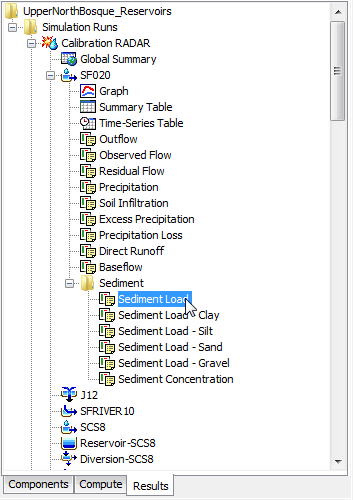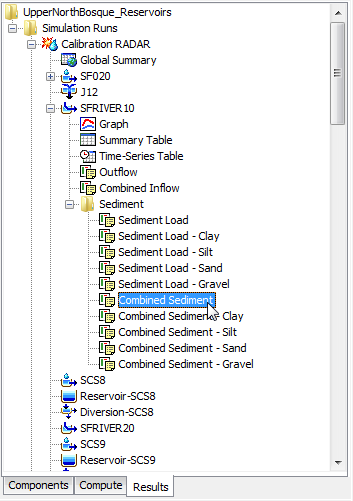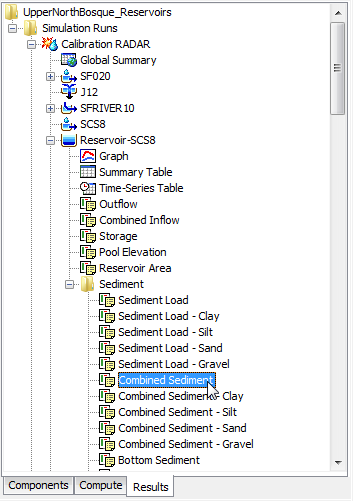Download PDF
Download page Viewing Erosion and Sediment Results.
Viewing Erosion and Sediment Results
The primary results from erosion and sediment components are time-series. Available results depend on the type of element, but always include the total sediment load leaving the element. The total sediment is also separated out by grain size class or subclass. These results are accessed in the Watershed Explorer on the "Results" tab. When erosion and sediment components are activated, a special folder for erosion and sediment results is added under each element icon.
All of the erosion and sediment time-series data computed by an individual element are available for viewing. Click on a time-series node to preview the data in the Component Editor. You may select multiple time-series data by holding the shift or control key while using the mouse to click on additional nodes. The selected time-series may come from different elements in the same simulation, or the same element in different simulations. Results can also be combined from different types of simulations including simulation runs, optimization trials, depth-area analyses, and forecast alternatives. The selected time-series data will automatically be partitioned into groups by data type if the erosion and sediment results are combined with other types of results such as flow or stage.
Subbasin
The erosion results for each subbasin include the time-series of total sediment load leaving the subbasin. The total sediment is the sum of all grain size classes. Also included is the time-series of sediment load in each grain size class. The total sediment concentration in the outflow is also included among the results. The organization of the results is shown in Figure 1.

Figure 1. Sediment results for a subbasin element.
Reach
The sediment results for each reach include the time-series of total sediment load entering the reach, and the total sediment load leaving the reach. The total sediment is the sum of all grain size classes. Also included is the time-series of sediment load in each grain size class both coming into the reach and leaving the reach. The organization of the results is shown in Figure 2.

Figure 2. Sediment results for a reach element.
Reservoir
The sediment results for each reservoir include the time-series of total sediment load entering the reservoir, and the total sediment load leaving the reservoir. Additionally, the time-series of total sediment load settled to the bottom of the reservoir is available, along with the time-series of sediment load in suspension in the reservoir pool. For each of the four categories, the total sediment is the sum of all grain size classes. Also included is the time-series of sediment load in each grain size class for each of the four categories of sediment at a reservoir. The organization of the results is shown in Figure 3.

Figure 3. Sediment results for a reservoir element.
Source
The sediment results for each source include the time-series of total sediment load leaving the source. The total sediment is the sum of all grain size classes. Also included is the time-series of sediment load within each grain size class.
Junction
The sediment results for each junction include the time-series of total sediment load leaving the junction. The total sediment is the sum of all sediment from each of the upstream elements. Also included is the time-series of sediment load for each grain size class, computed similarly to the total load but specific to each grain size.
Diversion
The sediment results for each diversion include the time-series of total sediment load entering the diversion, and the total sediment load leaving the diversion. The total sediment is the sum of all grain size classes. Additionally, the total sediment load in the diverted flow is available. Also included is the time-series of sediment load in each grain size class for each of the three categories of sediment at a diversion.
Sink
The sediment results for each sink include the time-series of total sediment load entering the sink. The total sediment is the sum of all sediment from each of the upstream elements. Also included is the time-series of sediment load for each grain size class, computed similarly to the total load but specific to each grain size.